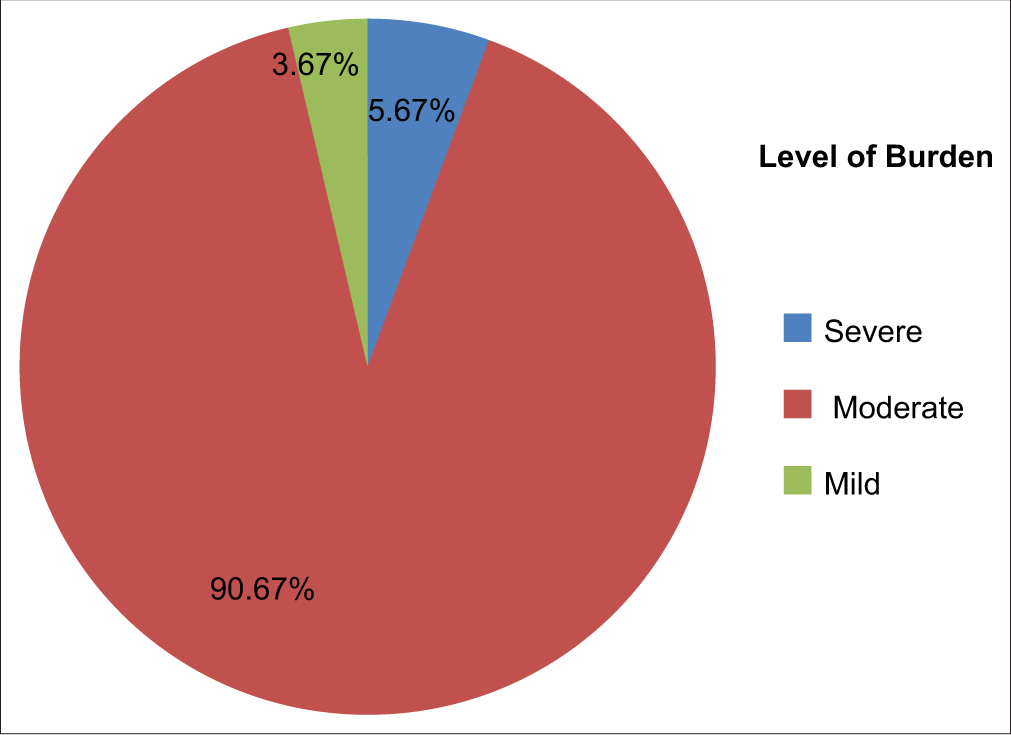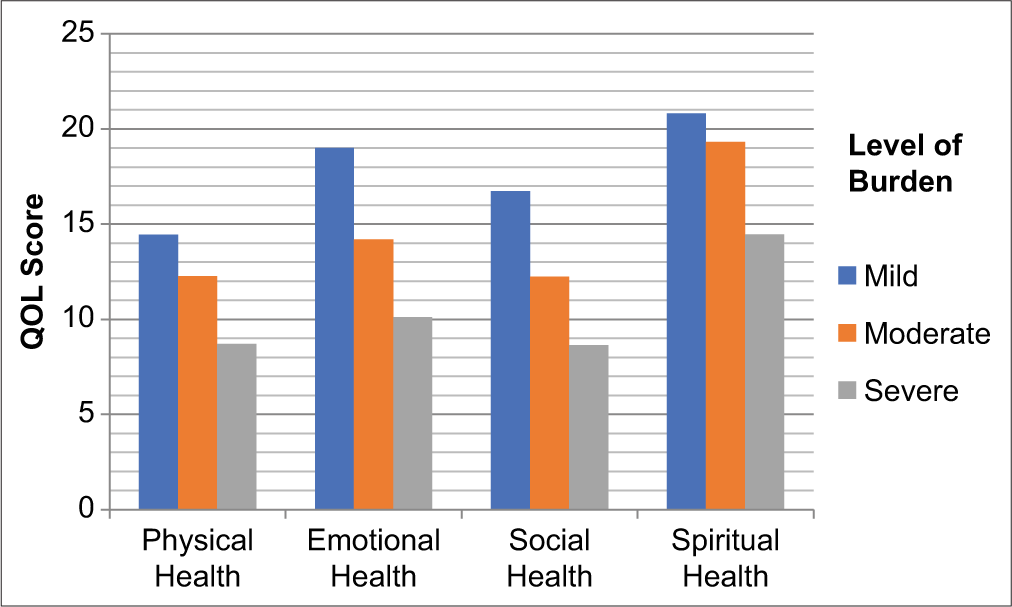Translate this page into:
Caregiver Burden and Quality of Life among Family Caregivers of Cancer Patients Admitted in Regional Cancer Centre Government Medical College, Jammu: A Prospective Observational Study

*Corresponding author: Vidushi Khajuria, Department of Pharmacology and Therapeutics, Government Medical College, Jammu, Jammu and Kashmir, India. vidushykhajuria@gmail.com
-
Received: ,
Accepted: ,
How to cite this article: Khajuria V, Kumar R, Choudhary S, Sharma R, Sadiq S. Caregiver Burden and QOL among Family Caregivers of Cancer Patients Admitted in Regional Cancer Centre, Government Medical College, Jammu: A Prospective Observational Study. Indian Cancer Awareness J. doi: 10.25259/ICAJ_22_2024
Abstract
Objectives:
We aimed to assess caregiver burden and quality of life (QOL) of family caregivers of cancer patients.
Materials and Methods:
A prospective observational study was conducted in Department of Pharmacology and Therapeutics in collaboration with Regional Cancer Centre, Government Medical College (GMC), Jammu for a period of six months. The assessment of care giving burden was done using the pre-designed questionnaire form which included questions pertaining to important set of domains i.e., Physical Health, Emotional Health, Social Health and Spirituality of the caregivers.
Results:
The enrolled population sample consisted of 300 Caregivers aged 18-65 years, mostly males (65.33%), married (84.33%), employed (71.67%) with 29.67% co-morbidities. In this study, 90.67% of caregivers reported moderate caregiver burden.
Conclusion:
Caregivers are experiencing significant burden, particularly with respect to their physical, social, emotional, and spiritual health. Supportive care needs to be sought to alleviate caregiving burden and improve the QOL of caregivers especially those attending hospitalized patients.
Keywords
Cancer
Caregiving burden
pre-designed questionnaire
Family caregiver
Quality of life
INTRODUCTION
Cancer is a life-threatening illness that causes large-scale morbidity and mortality globally.[1] Over the years, longer life expectancy has led to an increase in the elderly and young adult ratio. As a result of an increase in the elderly population, the number of patients with chronic diseases is also rising, and their prognosis is improving.[2] Cancer and related comorbidities restrict the daily activities of sufferers and bring about considerable physical, mental, social as well as spiritual changes in the lives of both patient and their relatives. As a result of the high impact of the disease, the number of informal caregivers (ICs) who are providing care and support to these patients is also likely to increase, who, in turn, are responsible for the patient care at home and carrying out specific instructions given by their treating health care personnel.[3] Palliative care (PC) ensures proper health care to cancer patients, thus impacting the patient’s course of disease progression, survival and quality of life (QOL). PC has been a positive adjunct to ensure proper health care impacting the course of disease progression with a special inclination toward survival and QOL. Family caregivers take up the responsibility with little or no training as well as with limited resources in aiding personal care, supporting them psychologically and also by financially taking up the things to care for their burden.[4,5] As per the World Health Organization definition, PC not only aims to maintain patients’ QOL but also to include the support of family caregivers.[5] However, family caregivers do have an imbalance in terms of caregiving responsibility, as it negatively impacts their QOL. They frequently lack sleep, feel tired, and may eventually suffer from stress, anxiety and depression.[6] Moreover, family caregivers experience financial burdens due to the cost and complexity of cancer treatment, which may continue even after the death of the patient.[7] However, spiritual beliefs can help patients cope with disease and face death.[8]
Therefore, this study was taken up in order to assess the caregiver burden and QOL among family caregivers of cancer patients.
MATERIALS AND METHODS
A total of 300 ICs of cancer patients with advanced cancer between 18 and 65 years of age who willingly consented to participate were enrolled in the study. A pre-designed questionnaire containing demographic details, educational status, occupation, comorbidities of the caregiver and diagnosis of the patient was used as the study tool. All the enrolled caregivers were asked to fill out the questionnaire form. The caregivers who were unable to fill out the questionnaire form were excluded from the study.
The quantitative data were reported as Mean ± Standard deviation, and significance was tested using a t-test. The qualitative data were tabulated and represented in percentages.
RESULTS
Table 1 reveals the demographic characteristics of caregivers. Males outnumbered females in the ratio of 1.8:1. Age pattern revealed that a maximum number of 76 (25.33%) of caregivers were 41–50 years with a mean age of 42.40 ± 12.75. More than half, 153 (51%) of the caregivers were educated, among which 181 (60.33%) caregivers were self-employed and 88 (10.33%) were unemployed. Nearly one-third (29.67%) of the caregivers had comorbidities such as hypertension, hypothyroidism, diabetes, anxiety and stress. The participants were evaluated based on the pre-designed questionnaire where the score was given to a single question ranging from 1 to 5. A total of 19 questions were designed laying emphasis on four domains, that is physical health, emotional health, social health and spiritual health. A high score indicated less burden in caregivers with high QOL. The level of burden among the caregivers was divided into severe, moderate and mild.[9] Caregivers with a total score between 19–43, 44–69 and 70–95 were kept in the severe, moderate and mild category, respectively. Among the 300 caregivers in our study, the majority (90.67%) showed moderate burden, and only 5.67% of the caregivers had severe burden, and 3.67% had mild burden [Table 2 and Figure 1].
| Characterstics | Total Number | Percentage(%) |
|---|---|---|
| Age Group ( in Years) | ||
| 11-20 | 9 | 3.00% |
| 21-30 | 64 | 21.33% |
| 31-40 | 69 | 23.00% |
| 41-50 | 76 | 25.33% |
| 51-60 | 60 | 20.00% |
| 61-70 | 22 | 7.33% |
| Mean age±SD | 42.40+12.75 | |
| Gender | ||
| a) Male | 196 | 65.33% |
| b) Female | 104 | 34.67% |
| Education Status | ||
| a) Under Matric | 107 | 35.67% |
| b) Matric | 40 | 13.33% |
| c) Graduate | 132 | 44.00% |
| d) Post Graduate | 21 | 7.00% |
| Marrital Status | ||
| a) Married | 253 | 84.33% |
| b) Unmarried | 47 | 15.67% |
| Occupation | ||
| a) Govt. Employee | 31 | 10.33% |
| b) Self Employee | 181 | 60.33% |
| c) Unemployed | 88 | 29.33% |
| Comorbidities | 89 | 29.67% |
SD: Standard deviation
| Level of Burden | Total Number | Percentage(%) |
|---|---|---|
| Severe (19-43) | 17 | 5.67% |
| Moderate (44-69) | 272 | 90.67% |
| Mild (70-95) | 11 | 3.67% |

- Burden on caregivers based on score in the questionnaire.
Table 3 reveals the relationship between the caregiver burden to the caregiver’s occupation and gender. The severe burden was found in 11 female and 6 male caregivers, of which 10 were employed and 7 were unemployed. Similarly, 180 male caregivers and 92 female caregivers were found to have a moderate level of burden. Whereas 191 of the employed caregivers and 81 unemployed caregivers too had a moderate level of burden.
| Level of Burden | Male Caregiver | Female Caregiver | Unemployed | Employed |
|---|---|---|---|---|
| Severe (19-43) | 6 | 11 | 7 | 10 |
| Moderate (44-69) | 180 | 92 | 81 | 191 |
| Mild (70-95) | 10 | 1 | 0 | 11 |
The QOL of caregivers in relation to their burden is shown in Table 4. The burden was accessed over physical, emotional, social and spiritual health domains. We observed a significant decrease in QOL scores across all four domains from mild-to-moderate and moderate-to-severe [Figure 2]. The spiritual health domain had the highest score, indicating a firm spiritual belief.
| QOL Score | Mild Burden | Moderate Burden | Severe Burden | |||
|---|---|---|---|---|---|---|
| Mean | SD | Mean | SD | Mean | SD | |
| Physical Health (4-20) | 14.455 | 0.820 | 12.257 | 1.388 | 8.706 | 0.772 |
| Emotional Health (5-25) | 19.000 | 1.265 | 14.191 | 1.628 | 10.118 | 1.111 |
| Social Health (5-25) | 16.727 | 0.786 | 12.254 | 1.502 | 8.647 | 0.493 |
| Spiritual Health (5-25) | 20.818 | 1.401 | 19.324 | 1.661 | 14.471 | 1.125 |
QOL: Quality of life

- Quality of life (QOL) of caregivers in relation to their burden.
DISCUSSION
Our study is the first of its kind in the region to untangle the relationship between caregiver burden, different social relationship concepts and caregiver health by testing different models of the stress process paradigm.
In our study, male caregivers outnumbered females, and one-fourth (25.33%) of the caregivers were in the age group of 41–50 years. Moreover, people from close relations such as spouses, children or parents were among the majority of the caregivers. The female caregivers experienced a greater burden than male caregivers. Some previous studies have depicted that female caregivers reported a greater burden than males.[10,11] This is mainly due to the caring and nurturing approach of the women, and females have reportedly felt more obligated toward caregiving. Moreover, women are less likely to prioritise their interests and needs over their partners and devote themselves mentally and physically to caring for their partner and other family members. Interestingly, Ahmad Zubaidi et al.[12] observed a lesser burden on female caregivers as compared to males.
In the present study, 3.67% and 90.67% of caregivers were observed to have mild and moderate burden, respectively. Moreover, severe burden was observed in 5.67% of caregivers. In another study, Mishra et al.[4] reported mild-to-moderate burden in 70.22% and moderate-to-severe burden in 21.28% of the caregivers. Similar observations were reported by Mirsoleymani et al.[13] in their study conducted on Iranian cancer patients, where a significant percentage (48.1%) of caregivers were found to have a high burden. Contradictory results had been reported by Lukhmane et al.[14] which suggested that 56.6% of the family caregivers had no or minimal burden, and 43.5% had a burden varying from severe while caring for cancer patients. The caregiver burden in our study was mainly moderate due to the Indian family set-up. The joint family setup and the family values in India are known for providing good social and economic support during times of illness or crisis.
The level of education has long been associated with health literacy. Highly educated caregivers are presumed to be more resourceful and problem-focused during crises. In the present study, 51% of the caregivers were qualified, graduated and above. However, higher health literacy could also make caregivers aware of the prognosis and subsequent challenges and may contribute to unwanted psychological manifestation that creates an emotional burden.[12] Oedekoven et al.[15] reported a high caregiver burden in educated ICs in Germany. They depicted that educated caregivers are worried about the loss of self-fulfilment, autonomy and interference with their work performance while giving care to terminally ill patients. In the Netherlands, low caregiver esteem was observed in educated caregivers of cancer patients post-discharge.[16] Caregivers with low self-esteem have been associated with caregivers’ burden.
This study revealed that spiritual health has a higher QOL score among all the domains. This indicates that religiousness and faith help caregivers cope with the suffering associated with the care of their relatives with advanced cancer.[17]
Study limitations
Being a cross-sectional analysis, it is difficult to determine the causal relationship between different variables and caregiver burden. The self-reporting is vulnerable to individual and social desirability bias and respondent’s honesty.
CONCLUSION
A total of 300 caregivers participated in our study; among them, 90.67% of caregivers showed moderate burden, 5.67% of the caregivers had severe burden, and only 3.67% had mild burden. There is a significant decrease in the QOL score across all four domains from mild-to-moderate to moderate-to-severe. Spiritual health in the caregivers is the least affected among all the four domains.
Ethical approval
The research/study was approved by the Institutional Review Board at Institutional Ethical Committee Government Medical College Jammu, number IEC/GMCJ/2022/1181, dated 14 November 2022.
Declaration of patient consent
The authors certify that they have obtained all appropriate patient consent.
Conflicts of interest
There are no conflicts of interest.
Use of artificial intelligence (AI)-assisted technology for manuscript preparation
The authors confirm that there was no use of artificial intelligence (AI)-assisted technology for assisting in the writing or editing of the manuscript and no images were manipulated using AI.
Financial support and sponsorship
Nil.
References
- Assessment of Caregiving Burden of Family Caregivers of Advanced Cancer Patients and Their Satisfaction with the Dedicated Inpatient Palliative Care Provided to Their Patients: A Cross-Sectional Study from a Tertiary Care Centre in South Asia. Asian Pac J Cancer Prev. 2021;22:2109-15.
- [CrossRef] [Google Scholar]
- Informal Caregiver Burnout? Development of a Theoretical Framework to Understand the Impact of Caregiving. Front Psychol. 2019;10:1748.
- [CrossRef] [Google Scholar]
- Caregiver Burden and Quality of Life among Family Caregivers of Cancer Patients on Chemotherapy: A Prospective Observational Study. Indian J Palliat Care. 2021;27:109-12.
- [CrossRef] [Google Scholar]
- Correlation between Patient Quality of Life in Palliative Care and Burden of Their Family Caregivers: A Prospective Observational Cohort Study. BMC Palliat Care. 2016;15:4.
- [CrossRef] [Google Scholar]
- Psychological Distress and Quality of Life of Palliative Cancer Patients and Their Caring Relatives During Home Care. Support Care Cancer. 2014;22:2775-82.
- [CrossRef] [Google Scholar]
- Economic Burden Associated with Cancer Caregiving. Semin Oncol Nurs. 2019;35:333-6.
- [CrossRef] [Google Scholar]
- The role of spirituality in health care. Proc (Bayl Univ Med Cent). 2001;14:352-7.
- [CrossRef] [Google Scholar]
- WHO QOL-BREF In: US Version. Seattle, Washington, DC: University of Washington; 1997.
- [Google Scholar]
- Explaining the Gender Gap in the Caregiving Burden of Partner Caregivers. J Gerontol B Psychol Sci Soc Sci. 2019;74:309-17.
- [Google Scholar]
- The Caregiver Role in Palliative Care: A Systematic Review of Literature. Health Care Curr Rev. 2015;3:2.
- [Google Scholar]
- Caregiver Burden among Informal Caregivers in the Largest Specialized Palliative Care Unit in Malaysia: A Cross Sectional Study. BMC Palliat Care. 2020;19:186.
- [CrossRef] [Google Scholar]
- Predictors of Caregiver Burden in Iranian Family Caregivers of Cancer Patients. J Educ Health Promot. 2017;6:91.
- [CrossRef] [Google Scholar]
- Family Caregiver's Burden: A Hospital Based Study in 2010 among Cancer Patients from Delhi. Indian J Cancer. 2015;52:146-51.
- [CrossRef] [Google Scholar]
- Association between Informal Caregiver's Burden and Educational Level. J Gerontopsychol Geriatr Psychiatry. 2019;32:19-29.
- [CrossRef] [Google Scholar]
- Determinants of Caregiving Experiences and Mental Health of Partners of Cancer Patients. Cancer. 1999;86:577-88.
- [CrossRef] [Google Scholar]
- Spirituality Alleviates the Burden on Family Members Caring for Patients Receiving Palliative Care Exclusively. BMC Palliat Care. 2020;19:77.
- [CrossRef] [Google Scholar]






